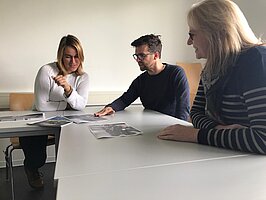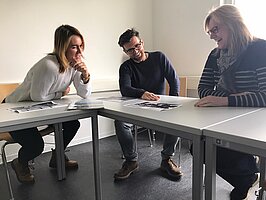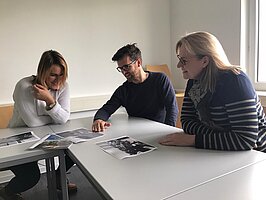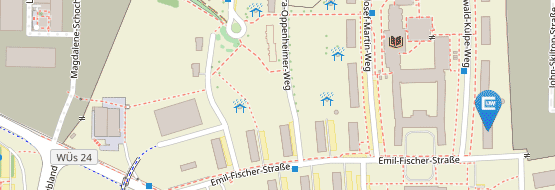Photolangage I



Aim of the method/strategy
- To develop reflection/critical thinking on students’ learning in a specific situation or even a specific course;
- To promote analysis and reflection on learning based on a photo taken by students themselves relating to a significant situation (event, object, image, etc.);
- To enable students to self-assess learning related to situations that were important for their understanding of the topics approached in the course attended.
Setting
- Bachelor’s and master’s degree courses classroom, university building
Type of the course, curriculum, number of students
- Photolangage: students’ self-evaluation of learning developed in a specific situation or in the course they are attending
- Bachelor’s and master’s degree courses (e.g. in adult education)
- Max. 15 students
Description of method/strategy
- Step 1
In the first session of a course, students are asked to bring a photo in the last session of the course. The picture (of an object, a person/multiple persons, an event, an image, etc.) has to be relevant for each student in the sense that it has to reflect a significant learning outcome the student has achieved. This picture may refer to a specific situation outside the course or something that occurred during the development of the course. As this activity follows photolangage guidelines, some general information about photolangage and about relevant learning experiences should be given to students.
- Step 2
While the course is being developed, the student chooses an existing photo or takes a new photo of a situation that occurs while the course sessions are being developed. He/she may take a photo of an object, a person/multiple persons, or a situation that represents a piece of relevant learning that has challenged the way the student was thinking previously. The photo needs to be in black and white and preferably printed in A4 format. The photo presents a metaphor of significant learning that allows the student to think critically and to see the world around him/her in a different way.
- Step 3
In the last session of a course, each student is asked to bring the photo that expresses their learning outcome. The idea is to show the photo to the other students, initiating a discussion about what the photo might mean both for the student who took it and for the others. The purpose is to promote analysis and reflection on learning based on a photo, an image taken by each student relating to a significant event, object, or image that reflects students’ learning. By discussing a significant photo and by understanding learning as a challenging event, each student explains how the picture represents the knowledge and skills they developed and a new way of understanding a situation or possibly a topic addressed in the course.
Materials required
Students need a camera (their mobile phone camera will generally do); after taking the photo, they need to print the image in black and white on A4 paper. Students need to bring this printout to the last session of the course.
Origin and theoretical framework
Photolanguage is a tool used to facilitate personal expression and verbal interaction in small groups. According to Bessell et al. (2007, p. 558), ‘it is a method that utilizes black-and-white photographs that have been carefully selected for their aesthetic qualities, their ability to promote thoughtful reflection within the viewer, and their strength in stimulating memory, emotions, and the imagination’. It was initially used in counselling and clinical therapy. In present times, it is used in many settings, including adult and community education (Griswold & Wigffall, 2015). This activity allows for critical thinking about learning developed by students during their lives, and it is a means of connecting learning to the topics approached in a course they attended. In this context, learning refers to knowledge and skills developed by students after facing a challenging situation that involves thinking and critical reflection and different ways of looking at the world. Photos chosen by students can relate to transformative learning, in the sense that the image selected may allow the development of some of the phases referred to by Mezirow (2000).
Risks and advantages
Advantages:
Students refer to learning developed by relating to the meaning the photo may express; they may refer to dilemmas, troubling events, discomfort, or to emotions, and it becomes easier to speak about what happened in an event or in the course itself; they may develop critical thinking skills and learn to express how a situation, and possibly a course in adult education, may have changed their way of looking at the world and at themselves.
Risks:
It depends on the students’ motivation to think about learning developed and to talk about it with others; students have to be willing to look at a picture, to think critically about it, to explain what it represents in terms of learning, and to say what it means to them when they look at it; the situation the picture represents has to be a significant learning occasion, possibly a transformative learning event (Mezirow, 2000); moral judgements are not acceptable.
Possible variations
- The method can be used in different settings, such as clinical therapy, counselling, education, evaluation, and even research.
Other examples where you think it could be used
The method can be used in different settings, such as the ones in which own’s learning can be debated with other people
Reccomendations
- A classroom with chairs (not tables) arranged in a circle is preferable. This arrangement of chairs is more conducive to discussions about meanings and emotions related to learning developed in different situations, or even during a course, as there are no physical obstacles (such as tables) between students.
References
Bessell, A. G. et al. (2007). Photolanguage: How a picture can inspire a thousand words. American Journal of Evaluation, 28, 558-569. http://photolanguage.co.uk/ https://www.youtube.com/watch?v=CBI84PpC_0A
Griswold, W. & Wigfall, L. B. J. (2015). Photolanguage as a research tool in adult and community education. Adult Education Research Conference. https://newprairiepress.org/aerc/2015/ roundtables/5
Mezirow, J. (2000). Learning as transformation: Critical perspectives on a theory in progress. San Francisco: Jossey Bass.
Contact Person
Paula Guimaraes ( pguimaraes@ie.ulisboa.pt )
Natalia Alves ( nalves@ie.ulisboa.pt )


